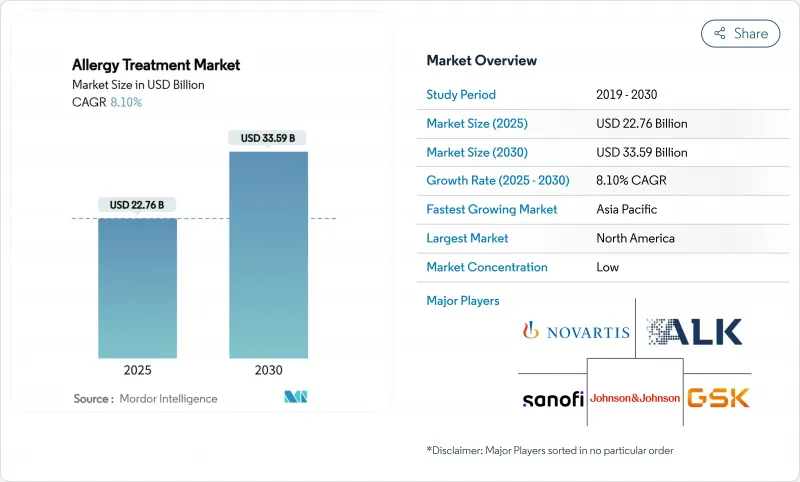
|
市場調査レポート
商品コード
1851861
アレルギー治療:市場シェア分析、産業動向、統計、成長予測(2025年~2030年)Allergy Treatment - Market Share Analysis, Industry Trends & Statistics, Growth Forecasts (2025 - 2030) |
||||||
カスタマイズ可能
適宜更新あり
|
|||||||
| アレルギー治療:市場シェア分析、産業動向、統計、成長予測(2025年~2030年) |
|
出版日: 2025年07月31日
発行: Mordor Intelligence
ページ情報: 英文 135 Pages
納期: 2~3営業日
|
概要
世界のアレルギー治療市場規模は2025年に227億6,000万米ドルに達し、2030年には335億9,000万米ドルに拡大し、予測期間中のCAGRは8.10%を記録すると予測されています。

加速する疾病の蔓延、気候に起因するアレルゲンの増幅、画期的な生物製剤が総体として需要を押し上げている一方、新たなデジタルヘルスモデルがアクセスとアドヒアランスを拡大しています。オマリズマブが初の多食品適応を獲得して以来、競争企業間の敵対関係は熾烈さを増しており、大手製薬企業と機敏なバイオテクノロジー企業の両方が直接のライバル関係にあります。バイオシミラーによる代替を加速させる規制上のイニシアチブは、価格圧力を高めると同時に、デリバリー技術、免疫療法の個別化、患者中心の医療における技術革新を刺激しています。地理的な乖離は依然として顕著である:北米は生物学的製剤への支出で主導権を維持しているのに対し、アジア太平洋は都市化の進展により感作レベルが高まっており、免疫療法の急速な普及を記録しています。
世界のアレルギー治療市場の動向と洞察
アレルギー性鼻炎と喘息の有病率の上昇
急増する都市大気汚染が酸化ストレスを促進し、免疫反応をTH2プロファイルに反転させ、アレルギー治療市場における処方抗ヒスタミン薬、ロイコトリエン拮抗薬、生物学的製剤の需要を支えています。北京からデリーまでの大都市では、感作率が50%を超えており、米国における費用負担はすでに年間34億米ドルを超えています。成人の30%、小児の40%が罹患するという鼻炎の世界的な広がりから、鼻炎は唯一最大の患者層であり、確実な収益基盤となっています。
セルフメディケーションとOTC薬に対する患者の嗜好の高まり
忍容性の高い第2世代抗ヒスタミン薬と経鼻コルチコステロイド薬が処方薬からOTC薬に移行し、消費者の手に届く範囲が広がり、アレルギー治療市場全体の取引量が増加しています。小売店の棚の目立つ位置は、デジタル症状チェッカーと一致しており、軽度の患者を自己管理ケアと鼻づまり除去薬の併用に誘導しています。特に北米と西欧では、地域薬局での診断待ち時間の短さが、この行動をより強固なものにしています。
低価格バイオシミラーの普及が加速し、価格/利益率が低下
互換性のあるオマリズマブとウステキヌマブのバイオシミラーが相次いで単価を最大40%引き下げ、アレルギー治療市場におけるオリジネーターのトップライン成長を圧迫しています。欧州では入札制度が普及を早め、新興国ではコスト削減が生物学的製剤へのアクセスへの入り口となります。オリジネーターは、プレミアムの位置づけを正当化するために、デバイスのアップグレードやリアルワールドエビデンスの書類で対応しています。
セグメント分析
鼻炎は2024年のアレルギー治療市場シェアで41.51%を占め、世界的な高い有病率とマルチモーダルな治療ツールキットを活用しています。市販の抗ヒスタミン薬、経鼻コルチコステロイド薬、SLIT錠剤が治療の柱となる一方、生物学的製剤が重篤な多感症患者を牽引しています。季節性および通年性のアレルギー性疾患は、共同で広範な処方基盤を維持し、緊急の治療クラスに関係なく基本的な需要を保証しています。
2030年までのCAGRが9.65%と最も急成長している食物アレルギーは、初の疾患修飾性生物学的製剤の承認と経口免疫療法の幅広いパイプラインの恩恵を受けています。成人発症アレルギーの疫学的認知により対象者が拡大し、学校ベースのアナフィラキシープロトコールにより予防的処方が拡大します。眼、皮膚、喘息、その他のニッチなアレルギーは、診断の強化や生物学的製剤の交差適応により、それぞれ処方数を増やしています。
抗アレルギー薬は、有利な償還、OTCの隆盛、成熟しつつあるジェネリック医薬品に支えられ、2024年のアレルギー治療市場シェアの65.53%を維持した。第二世代抗ヒスタミン薬、外用コルチコステロイド薬、ロイコトリエン遮断薬が安定した収益源を形成し、新規カテゴリーの価格変動を緩和しています。
免疫療法は2030年までのCAGRが10.85%になると予想されるが、これは長期的なコスト効率に対する支払側の認識と、在宅SLITレジメンに対する患者の嗜好の高まりを反映しています。臨床ガイドラインにより投与量と投与期間が標準化され、ばらつきが最小化され、臨床医の信頼が高まっています。皮下投与プロトコールは、高リスク患者において最大限の効果を得るためのゴールドスタンダードであり続ける一方、生物学的製剤とSLITの併用戦略は複雑な多感受性に対応するために登場し、アレルギー治療市場規模の提案を強化しています。
地域分析
北米の2024年におけるアレルギー治療市場シェア38.25%は、広範な保険適用、生物学的製剤の早期導入、専門医ネットワークの集中に起因します。米国は他地域に波及する規制上の先鞭をつけ、国内メーカーを早期収益とライフサイクル延長の優位な立場に置いています。バイオシミラー医薬品の普及は、代替品への躊躇やREMSの制約を考慮するとまだ緩やかであり、イノベーターの価格安定性は保たれています。
アジア太平洋地域の2030年までのCAGRは9.85%で、都市化に伴う感作性の急増、可処分所得の増加、一部の免疫療法をカバーする公的医療保険の拡大が原動力となり、他の全地域を上回る。アトピーの集団ではイエダニ感作率が90%を超え、地域に適合したアレルゲンエキスの需要が高まり、ALK-アベロとアボット社との提携のような共同販売契約が促進されます。モバイル・ファースト・ヘルスケアの導入により、大都市圏でのSLIT遠隔治療が加速し、治療範囲が拡大します。
欧州は普及が成熟しているが、バイオシミラーに優しい入札制度の下、価格圧縮に直面しています。同地域は免疫療法の品質とファーマコビジランスの標準化をリードしており、持続可能な収益成長に寄与しているが、その伸びは抑制されています。中東・アフリカと南米は、経済とサプライチェーンの不安定性により当面の牽引力は弱まるもの、専門医療インフラが徐々に改善され、新たなビジネスチャンスをもたらしています。
その他の特典:
- エクセル形式の市場予測(ME)シート
- 3ヶ月間のアナリストサポート
よくあるご質問
目次
第1章 イントロダクション
- 調査の前提条件と市場の定義
- 調査範囲
第2章 調査手法
第3章 エグゼクティブサマリー
第4章 市場情勢
- 市場概要
- 市場促進要因
- アレルギー性鼻炎と喘息の有病率の上昇
- セルフメディケーションとOTC医薬品に対する患者の嗜好の高まり
- 新規治療薬と生物製剤への投資の増加
- オンライン在宅SLITテレケアプラットフォームの拡大
- 抗IgEモノクローナル抗体の商業化
- 気候によるアレルゲン負荷の増幅
- 市場抑制要因
- 低価格バイオシミラーの普及が進み、価格/利益率が低下
- AITの長期的ベネフィットに対する患者・HCPの認識の低さ
- 生物学的製剤とSLIT療法の保険償還は限定的
- 天然アレルゲンエキスのサプライチェーンリスク
- ポーターのファイブフォース
- 新規参入業者の脅威
- 買い手の交渉力
- 供給企業の交渉力
- 代替品の脅威
- 競争企業間の敵対関係
第5章 市場規模と成長予測
- アレルギータイプ別
- 眼アレルギー
- 鼻炎
- 喘息
- 皮膚アレルギー
- 食物アレルギー
- その他のアレルギー
- 治療別
- 抗アレルギー薬
- 抗ヒスタミン薬- 第一世代
- 抗ヒスタミン薬- 第2/第3世代
- 副腎皮質ステロイド- 外用薬、吸入薬、全身薬
- 鬱血除去薬- 経口剤、点鼻薬
- ロイコトリエン受容体拮抗薬
- 生物製剤とmAbs
- 免疫療法
- 皮下注射(SCIT)
- 舌下投与(SLIT-錠剤、点滴)
- 抗アレルギー薬
- 剤形別
- 錠剤・カプセル
- 鼻腔スプレー
- 目薬
- 吸入器
- 注射器・自動注射器
- 流通チャネル別
- 病院薬局
- 小売薬局・ドラッグストア
- オンライン薬局
- 地域
- 北米
- 米国
- カナダ
- メキシコ
- 欧州
- ドイツ
- 英国
- フランス
- イタリア
- スペイン
- その他欧州地域
- アジア太平洋地域
- 中国
- 日本
- インド
- 韓国
- オーストラリア
- その他アジア太平洋地域
- 中東・アフリカ
- GCC
- 南アフリカ
- その他中東・アフリカ地域
- 南米
- ブラジル
- アルゼンチン
- その他南米
- 北米
第6章 競合情勢
- 市場集中度
- 市場シェア分析
- 企業プロファイル
- ALK-Abello A/S
- AbbVie Inc.
- Allergy Therapeutics plc
- Bausch Health Companies Inc.
- Alembic Pharmaceuticals Ltd.
- F. Hoffmann-La Roche Ltd.
- Nicox SA
- GSK plc
- Johnson & Johnson
- Laboratorios Leti S.A.
- Novartis AG
- Sanofi SA
- Teva Pharmaceutical Industries
- Merck KGaA
- Stallergenes Greer
- Cipla Ltd.
- AstraZeneca plc
- Pfizer Inc.
- Regeneron Pharmaceuticals
- Bayer AG

